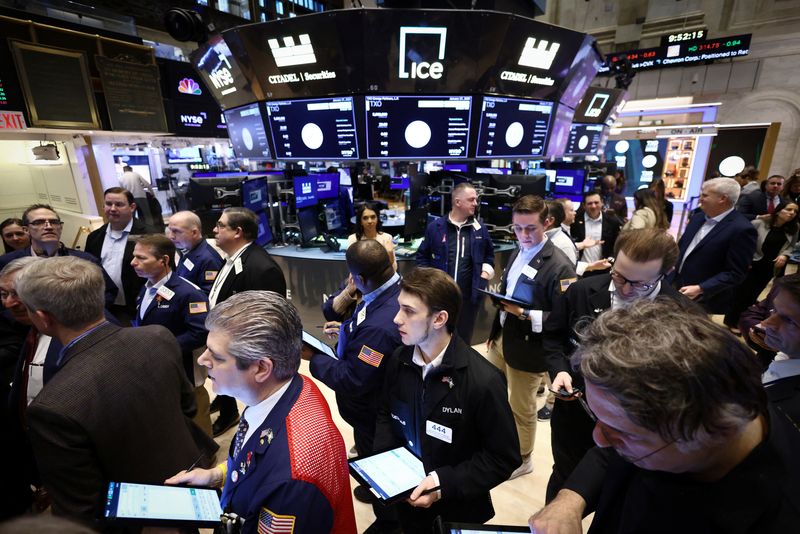Nasdaq ends lower as Treasury yields rise, Lyft plunges By Reuters
[ad_1]

© Reuters. FILE PHOTO: Traders work on the trading floor at the New York Stock Exchange (NYSE) in New York City, U.S., January 27, 2023. REUTERS/Andrew Kelly
By Carolina Mandl
(Reuters) – The Nasdaq ended lower on Friday as megacap growth stocks came under pressure after Treasury yields pointed to higher interest rates and shares of ride-hailing firm Lyft plunged following a downbeat profit forecast.
Yields on the benchmark 10-year Treasury note rose to their highest in more than a month following an auction on Thursday of 30-year bonds that saw weak demand. [US/]
“Investors are wondering what the bond market is telling us that economic indicators are not telling us,” said Sam Stovall, chief investment strategist at CFRA Research. “Higher bond yields are going to more adversely affect the higher growth technology companies.”
But a rally in energy stocks as oil prices climbed on Russia’s plans to cut crude supplies helped push up the Dow and the .
The ended up 169.52 points, or 0.5%, to 33,869.4, the S&P 500 gained 8.98 points, or 0.22%, to 4,090.48 and the dropped 71.46 points, or 0.61%, to 11,718.12.
The Nasdaq posted its first weekly fall this year, down 2.41%, while the S&P 500 ended the week lower 1.11% and the Dow Jones lost 0.17%, in a week dominated by hawkish commentary from U.S. Federal Reserve officials and earnings reports from more than half of the S&P 500 constituents.
That comes after a stellar performance by stocks in January. This month, however, strong jobs data and comments from Federal Reserve Chair Jerome Powell stoked worries about how much higher interest rates may need to climb.
“What has been going on for the last few days is that every other day there is a Fed governor going to talk hawkish,” said Kevin Rendino, chief executive of asset manager 180 Degree Capital.
The Russell 1000 Growth index that houses many large-cap growth names fell 0.33%.
Lyft Inc (NASDAQ:) plummeted 36.44% as it lowered prices, raising concerns it was falling behind bigger rival Uber Technologies (NYSE:) Inc. Uber shares also dropped 4.43%.
Most of the 11 major S&P 500 sectors edged higher. The energy sector jumped 3.92% as oil prices climbed on Russia’s plans to cut crude supplies, while the consumer discretionary sector fell 1.22%. [O/R]
More than half of the firms listed on the S&P 500 have reported earnings, with 69% beating profit estimates for the quarter, according to Refinitiv data.
U.S. consumer sentiment improved further in February month-on-month, but households expected higher inflation to persist over the next 12 months, the University of Michigan’s preliminary February reading showed.
After U.S. equities were rattled over the week by strong jobs data, investors are waiting for January consumer inflation data next week for clarity on the Fed’s rate-hike path.
Volume on U.S. exchanges was 10.43 billion shares, compared with the 11.85 billion average for the full session over the last 20 trading days.
Declining issues outnumbered advancing ones on the NYSE by a 1.03-to-1 ratio; on Nasdaq, a 1.35-to-1 ratio favored decliners.
The S&P 500 posted 3 new 52-week highs and no new lows; the Nasdaq Composite recorded 36 new highs and 68 new lows.
[ad_2]
Source link


